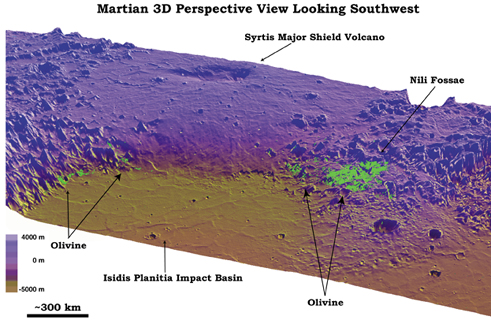 Contrary
to the prevailing idea that Mars once sustained a warm, wet climate similar
to Earth’s, new evidence shows that the planet may have been dry and cold
for much of its history. Spectral maps made using data from the Mars Global
Surveyor have revealed large areas covered by olivine — a group of greenish
magnesium-iron silicate minerals that are common in mafic igneous rocks, but
which weather rapidly when exposed to Earth’s humid climate.
Contrary
to the prevailing idea that Mars once sustained a warm, wet climate similar
to Earth’s, new evidence shows that the planet may have been dry and cold
for much of its history. Spectral maps made using data from the Mars Global
Surveyor have revealed large areas covered by olivine — a group of greenish
magnesium-iron silicate minerals that are common in mafic igneous rocks, but
which weather rapidly when exposed to Earth’s humid climate.This 3-D perspective of the the Nili Fossae region of Mars shows areas with large olivine deposits. The image was created by combining Mars Orbiter Laser Altimeter elevation data and Thermal Emission Spectrometer spectral data from the Mars Global Surveyor spacecraft. Green areas indicate olivine. The yellow-brown and blue colors represent elevation data. Courtesy of NASA/USGS.
“Our observations of regional exposures of olivine could have implications for warm-wet periods in martian climatic history, if the age of the olivine could be constrained,” wrote Todd Hoefen of the U.S. Geological Survey and colleagues in the Oct. 24 Science.
The research team reports the discovery of a 30,000-square-kilometer expanse of olivine in the Nili Fossae region of Mars — an area of fractures and down-dropped blocks of crust, called grabens, associated with the Isidis impact basin. Lava flows from the nearby Syrtis Major volcano have covered part of the fracture-and-graben complex. These flows have provided an age estimate for the Nili Fossae region.
Because the Isidis impact basin is older than Syrtis Major, which scientists have dated to 3.6 billion years ago, Nili Fossae formed at least 3.6 billion years ago, Hoefen’s team hypothesize.
The researchers propose that faulting that occurred shortly after the Isidis impact event exposed the olivine. However, they acknowledge that the olivine could have been uncovered more recently by means of physical erosion and mass movements of materials. “We cannot put an exact time on when the olivine was uncovered,” Hoefen says.
“If the olivine was exposed shortly after the impact event, the martian surface may have been dry and cold for more than 3 billion years,” the research team wrote, “but if the olivine was recently uncovered at the surface, then it could have been cold and dry for as little as a few thousand years.”
The spectral data were gathered by the Thermal Emission Spectrometer (TES) aboard the Mars Global Surveyor, which began orbiting Mars in September 1997. Researchers corrected the data for the presence of dust, carbon dioxide, water-ice aerosols and water vapor, all of which can distort the spectra. The team then compared the Mars data to a library of spectra from minerals on Earth, including olivine grains from the Kiglapait mafic intrusion in Labrador, Canada, and from Hawaii’s famous green sand beaches, which weathered from olivine-rich basaltic lavas.
The chemical composition of olivine varies along a series from forsterite, the magnesium end-member, to fayalite, the iron end-member. The team found that the Mars spectra most closely matched the spectra of high-iron grains from the Kiglapait intrusion.
Sara Martinez-Alonso, a University of Colorado geologist who studies martian surface mineralogy using TES data, says that the discovery of this large olivine deposit is exciting for several reasons — “for its genetic implications, in terms of the type of igneous activity that produced it, for its weathering (or lack thereof) implications and consequently for its climatic implications.”
Although the Nili Fossae was the single largest exposure, Hoefen’s team found that olivine covers more than 2.5 million square kilometers of the surface of Mars, representing about 3 percent of the area between 60 degrees north and 60 degrees south latitude.
Sara Pratt
Geotimes contributing writer
Back to top

